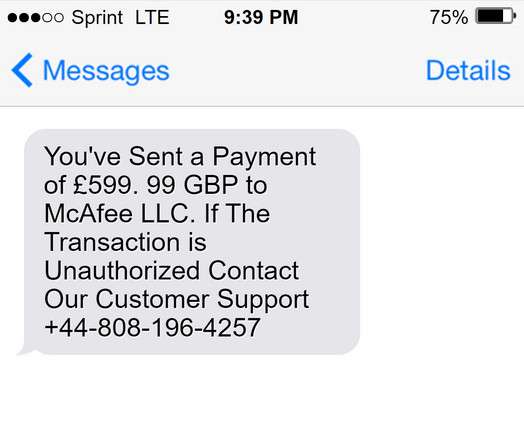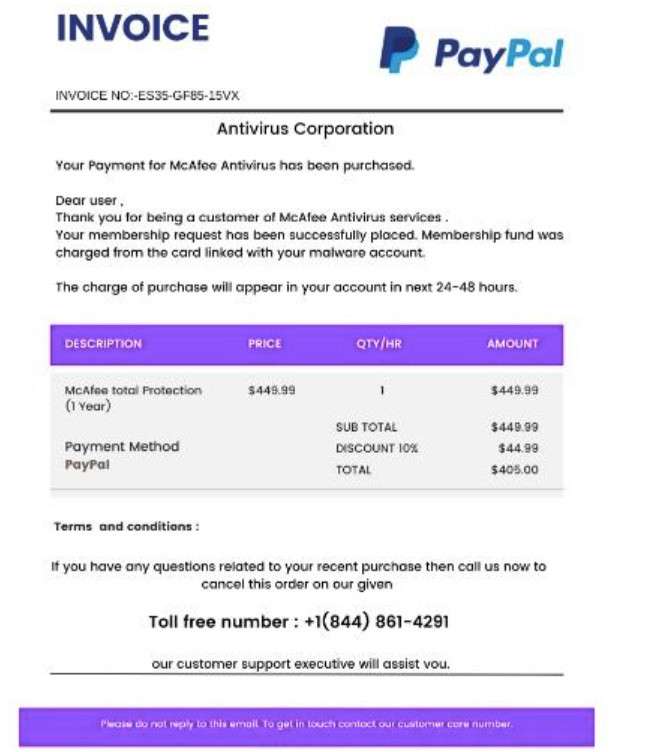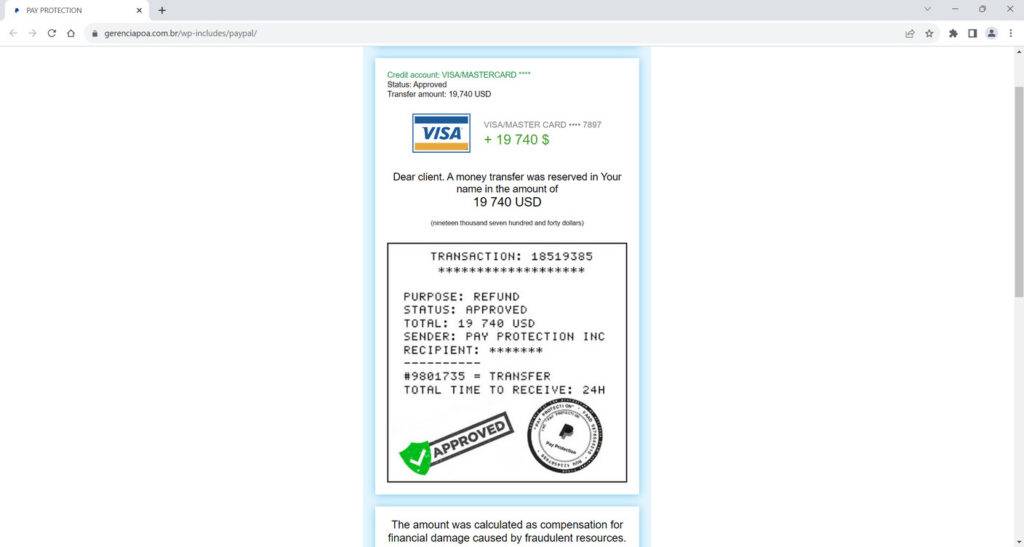A new tech support scam has emerged involving fake PayPal invoices for McAfee antivirus purchases. Fraudsters are sending phishing emails claiming a large McAfee transaction of $449.99 was processed via your PayPal account.
The emails state you must call the provided 1-888 number to cancel the unauthorized charge and get a refund. However, this phone number routes to smooth-talking scammers aiming to deceive victims into handing over money or sensitive data.
This scam combines two trusted brands – McAfee security and PayPal digital payments – to instill a sense of urgency in recipients to call the number provided before the supposed charge finalizes. But the entire thing is a fraudulent con designed to steal your credit card details, hijack online accounts, and siphon funds.
In this comprehensive guide, we’ll break down how the McAfee refund scam works, what techniques to watch for, and the steps to take if you receive one of these deceitful emails. Forewarned is forearmed against this attack.



Overview of the McAfee Refund Scam
This emerging phishing scam leverages the brands of McAfee security and PayPal digital payments to deceive recipients with fake subscription invoices. The criminals send emails about an unauthorized $449.99 McAfee transaction processed through your PayPal account.
The message urges you to call the provided 1-888 number immediately to cancel the charge and get a refund before it’s too late. However, the number actually routes to manipulative scammers aiming to steal your money, data, or both.
This scam is essentially a twisted hybrid of two common phishes – fake service bills and tech support cons. The McAfee angle exploits the ubiquity of their antivirus software, which boasts over 400 million users globally.
PayPal is also a household name, with around 300 million active registered accounts worldwide. Combined, an invoice seemingly tied to both services seems credible to most recipients.
The emails arrive completely out of the blue, so victims don’t think to cross-reference their McAfee and PayPal accounts to realize it’s a fake. Once on the phone with the “support reps”, the smooth-talking criminals utilize various social engineering tactics to gain trust and extract as much sensitive info as possible.
Some examples of the phony PayPal invoices for McAfee:
“We see an unauthorized transaction for McAfee was processed via your PayPal account. Please call 1-888-309-3405 immediately to dispute this $449.99 charge.”
“URGENT: A pending McAfee payment of $449.99 is set to process from your PayPal wallet today. If this was not authorized, call 1-888-309-3405 to cancel.”
“ALERT: A $449.99 payment to McAfee was initiated through your PayPal account without approval. Call 1-888-309-3405 now to stop processing and get a refund.”
Once victims call the number, the criminals utilize various lies and manipulation tactics, including:
- Falsely claiming the charge is due to a past auto-renewal or subscription you simply forgot about.
- Warning that your computer is infected with viruses, necessitating remote access to “resolve the issues causing errant billing”.
- Verifying your name, email, partial credit card number or recent PayPal transactions to convince you they’re legitimate.
- Threatening to suspend your PayPal or McAfee account if the charge isn’t paid immediately.
- Insisting a refund is being processed but first requiring you to verify account and billing details to “confirm your identity”.
- Pretending to be a PayPal supervisor or manager to assert authority on escalated calls.
- Offering discounted McAfee subscription renewal to compensate you for the trouble.
- Claiming the payment was an accidental authorized transaction that still legally must be honored.
- Asserting that the chargeback dispute window has already closed so payment can no longer be avoided.
With so many persuasive lies and manipulation tactics, it’s easy to understand how unsuspecting recipients can get fooled into providing sensitive information or even paying the fake charge. However, awareness of the typical ploys these tech support scammers use can help you recognize the signs of this con early on. Next, let’s go over what to do if you already fell victim.
How the McAfee Refund Scam Works
While simple in concept, effective execution requires careful planning and social engineering. Here are the steps:
1. Recipient Emails Are Compiled
Scammers purchase or steal massive databases of personal info on the black market containing thousands of emails, names, numbers, and addresses.
2. Fake Invoices Are Created
Using logos and templates, the scammers create fake PayPal invoices for $449.99 charges from McAfee. These mimic real PayPal bills for services.
3. Invoices Are Sent En Masse
The scammers blast out huge batches of the fake McAfee PayPal invoices to thousands of recipients per campaign.
4. Recipients Open and Review Invoices
Enough recipients will open the emails and see an unfamiliar $449.99 charge from McAfee via their PayPal account. Most will be alarmed, as they never made this purchase.
5. Victims Call the Scam Number
Worried about an unauthorized PayPal transaction, many recipients now call the 1-888 number listed on the fake invoice to cancel the bogus McAfee charge.
6. Scammers Pose as Support Agents
When victims call, the fraudsters answer posing convincingly as PayPal billing reps or McAfee support technicians. They confirm personal details to sound legitimate.
7. Scammers Request Remote Access
Claiming they need to diagnose technical issues causing the fake charge, the scammers try convincing victims to grant remote control of their computer.
8. Device Is Compromised Once Access Is Granted
With remote access, the scammers can now deploy malware, steal passwords, encrypt files, or mine cryptocurrency using the victim’s computer.
9. Fake Services and Charges Occur
Alternately, the criminals may sell unnecessary or non-existent “tech support” services to fix fictitious problems they convince victims their device has.
10. Payment and Financial Details Are Harvested
Through manipulative social engineering, the scammers obtain credit cards, online banking logins, SSNs, and gift card purchase codes allowing them to steal funds.
11. Additional Fraud Occurs With Stolen Data
With bank account access and logins successfully phished, the scammers can now conduct additional financial fraud, account draining, and identity theft.
This demonstrates how a single phishing email can ultimately compromise finances, data, and identity after scammers socially engineer victims over the phone. Next we’ll cover what to do if you already got scammed.
What to Do if You’ve Been Scammed By This PayPal McAfee Scam
If you already contacted the scammers and shared financial information or access, take these steps right away:
1. End All Contact with the Scammers
If still on the phone with them, hang up now. Block their number to prevent further manipulation. Never call them back for any reason.
2. Notify Your Bank and PayPal
Alert your bank and PayPal that your account information was potentially compromised. Freeze or close accounts if needed.
3. Reset ALL Passwords
Change the passwords on every online account, especially banking, email, and PayPal. Enable two-factor authentication also if possible.
4. Run Security Scans
Scan all your devices with comprehensive antivirus and anti-malware software to check for anything covertly installed by the scammers.
5. Monitor Accounts Closely
Watch accounts closely for fraudulent charges and activity stemming from the compromised details. Report any detected right away.
6. File Police Reports
File detailed police reports about the scam, providing screenshots of emails and other evidence. This creates an official record of the crime.
7. Report Details to Relevant Institutions
Inform PayPal, McAfee, the FTC, FCC, and FBI to provide information so they can investigate the scammers.
Acting quickly following a scam limits the damage and prevents further misuse of any stolen personal or financial data. Don’t let embarrassment stop you from speaking up as soon as unauthorized account activity is noticed.
Frequently Asked Questions About the Fake McAfee PayPal Invoice Scam
What is the McAfee PayPal invoice scam?
This is a phishing scam where scammers send fake PayPal emails about an unauthorized $449.99 McAfee antivirus purchase made through your PayPal account. The emails instruct you to call a provided 1-888 number to get a refund of the bogus charge. However, the number actually leads to scammers seeking your financial details.
How does the scam email appear?
The fake invoices use PayPal and McAfee logos and billing terminology. They reference your name and a large McAfee charge for $449.99. The scammers want it to seem like a valid accidental purchase was made.
Why do they want me to call them?
By getting you on the phone, scammers can use manipulation tactics and social engineering to gain remote access to your computer, trick you into buying gift cards, steal your credit card or bank account information, or harvest other sensitive personal data.
What techniques do the scammers use over the phone?
They may pretend to be PayPal or McAfee reps, threaten account suspension, claim the charge is due to a forgotten subscription, offer to refund the charge but first require account verification, insist the payment was authorized and must be paid, or warn your computer is infected to get remote access.
What are the scammer’s goals?
Ultimately they want to steal your credit card number, bank login credentials, social security number, or take over your computer remotely to deploy ransomware or steal personal data for identity fraud.
What should I do if I get a suspicious PayPal McAfee invoice?
Do NOT call the phone number in the email. Report the fake invoice to PayPal as phishing. Check your PayPal account history and McAfee subscriptions to confirm the charge is bogus. Delete the email right away.
I already called the scammers. What now?
End all contact immediately and block their number. Alert your bank and PayPal of potential account compromise. Reset all passwords and run antivirus scans to check for malware. Monitor your accounts closely for fraudulent activity and report the scam to authorities. Do NOT provide the scammers with any additional sensitive information or payments.
How can I avoid falling for this scam?
Use caution with any unexpected invoices demanding payment, especially for software purchases you don’t recall making. Verify independently by contacting the company directly using official channels only. Never call unsolicited numbers or provide banking details to random callers.
How can I secure my PayPal account?
Always use unique strong passwords. Enable two-factor authentication. Check your account often for unknown charges. Only link cards or bank accounts to PayPal that you fully trust. Never share PayPal account credentials or codes with anyone.
The Bottom Line
The fake McAfee PayPal invoice scam preys on a fear of surprise charges and urgent threats of account suspension if you don’t call. By posing as two major tech brands, the scammers hope to overwhelm logic and manipulate compliance.
But with insight into the scammer’s techniques, this attack can be recognized before falling victim. Use extreme caution with any unexpected transaction notices demanding immediate payment or account verification. Verify independently before providing sensitive information over the phone to a stranger.
Remember:
- Legit companies won’t demand unusual payments like gift cards.
- Confirm bills are real by contacting the company directly using official channels.
- Don’t trust urgent requests for your personal or financial data.
- Never provide banking details or access to random callers.
Stay vigilant online and over the phone to recognize signs of potential scams. Don’t hesitate to aggressively end any dubious interactions. With proper precautions taken, modern phone and phishing scams can be avoided.










